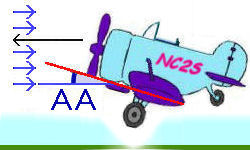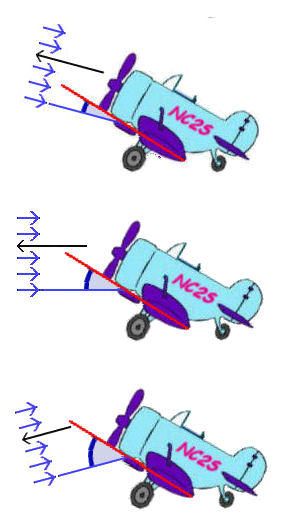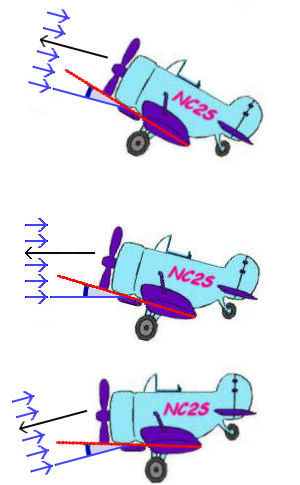Figure One: 15 Degree Angle of Attack, Level Flight

Pilot Courses of Instruction
Aerodynamics
Steve Sconfienza, Ph.D.
Airline Transport Pilot
Flight Instructor: Airplane Single and Multiengine; Instrument Airplane
cell: 518.366.3957
e-mail: docsteve@localnet.com
Angle of Attack
Angle of Attack is the angle at which the "chord line" meets the "relative wind."
Figure One: 15 Degree Angle of Attack, Level Flight

In figure one above, the black line with the arrow head is the direction of flight; the red line is the chord line of the wing, extend forward; the blue lines with the arrow heads are the relative wind (opposite the direction of flight), extend to meet the chord line. Angle AA is Angle of Attack.
Angle of attack and lift are related. In normal cruise flight, angle of attack and lift are directly related: increasing angle of attack increases lift; decreasing angle of attack decreases lift. The trade-off in this situation is airspeed. A pitch up to increase angle of attack trades-off airspeed for lift. A pitch down to decrease angle of attack trades-off lift for airspeed.
Changing pitch to change angle of attack to change airspeed works best as a concept in normal cruise flight because there are physical limits to how much pitch change can be accomplished, which become evident once the aircraft is operating outside of the normal cruise range.
Pitching down will cause the wing to generate less lift. A slight pitch change in normal cruise will cause the aircraft to descend, not so much because the nose is being pointed downward towards the earth (the nose of the aircraft [and/or the extended chord line of the wing] may still be above the horizon) as because it is pointed less upward, which reduces the angle of attack and reduces lift. Pitching forward, within reasonable limits, say five degrees, will thus reduce angle of attack, reducing lift (slightly), and at the same time allowing airspeed to increase (slightly). In a climb, pitching down slightly may only reduce lift sufficiently to slow the rate of climb, not stop it.
Pitching down will ultimately lose the ability to change angle of attack as the aircraft will simply enter a dive, likely to be ultimately at a very high speed, with, presumably, some lift-producing angle of attack (as the wing will continue to generate lift even if the aircraft is pointed straight down). Continued forward pressure (on the stick/wheel/yoke) continuing the aircraft past the vertical will cause the aircraft to go inverted and to continue in what amounts to an outside loop, and the aircraft will continue through the loop with a positive angle of attack, albeit with the wing (and, hopefully, the entire aircraft attached to it) inverted. [Note that this is an "outside loop," an extremely difficult maneuver: few aircraft, and even fewer pilots, are capable of completing it successfully.]
Pitching up is a different story. Pitching up a few degrees, say five degrees, will cause an increase in lift, and the aircraft to climb, at the expense of a few knots of airspeed. Again, the aircraft's attitude relative to the horizon is irrelevant. Even in a descent, with the nose down, a slight pitch up will increase lift and slow the rate of descent.
In theory, given sufficient speed or power, the aircraft may be pitched-up through a loop, maintaining a positive angle of attack throughout the entire loop. (It may be necessary through the top of the loop to add forward pressure on the stick to pitch the nose upward [note that in inverted flight, forward pressure on the stick pitches the nose upward].)
Angle of attack and the flight path are not necessarilly related: for any given angle of attack, an aircraft may be in a climb, in level flight, or in a descent. Other factors, such as airspeed, power setting, and weather conditions, will affect what the airplane is doing. Figure two below shows examples of aircraft in a stabilized flight condition, each with the same deck angle, but with different angles of attack.
| Condition | Angle of Attack | Deck Angle | ||
|---|---|---|---|---|
|
NOTE: Angles are descriptive only and are generally exaggerated well above what would be encountered in actual flight conditions. NOTE: For the aircraft to be in a steady state under each of the above conditions, power would have to be adjusted, from climb power to descent power. |
||||

|
A. | Climb | 15° | 30° (i.e., 30° above the horizon) |
| B. | Level Flight | 30° | 30° (i.e., 30° above the horizon) |
|
| C | Descent | 45° | 30° (i.e., 30° above the horizon) |
|
| Condition | Angle of Attack | Deck Angle | ||
|---|---|---|---|---|
|
NOTE: Angles are descriptive only and are generally exaggerated well above what would be encountered in actual flight conditions. NOTE: For the aircraft to be in a steady state under each of the above conditions, power would have to be adjusted, from climb power to descent power. |
||||

|
A. | Climb | 15° | 30° (i.e., 30° above the horizon) |
| B. | Level Flight | 15° | 15° (i.e., 15° above the horizon) |
|
| C | Descent | 15° | 0° (i.e., level with horizon) |
|
While too much downward pitch will ultimately place the aircraft into a screaming dive, ultimately having vary questionable results, too much upward pitch runs the risk of losing lift.
What happens is measured physically by changes in the aircraft's Lift Coefficient (LC). This cannot be modeled directly in the cockpit, but with a routine training pilots are able to infer what is happening.
The LC of a fixed-wing aircraft generally varies in a direct relationship with angle of attack; that is, increased angle of attack means an increased lift LC, while decreased angle of attack means a decreased LC. While increasing angle of attack is associated with increasing LC, this is only true up to the maximum LC, after which LC decreases (sometimes dramatically, but always with dramatic manifestations). The angle of attack at which that takes place is called the "Critical Angle of Attack."
As the angle of attack increases, separation of the airflow from the upper surface of the wing becomes more pronounced, leading to a reduction in the rate of increase of the lift coefficient (in graphical terms, the slope of the line becomes increasingly curved toward the horizontal: the graph of angle of attack is actually what is called a "J" curve, in this case an inverted J rotated about 45° to the right). Twists in the wing (typically with a higher angle of attack at the wing root), swept wings, and delta wings all have variations of the basic curve, but the curve is always similar.
A cambered straight wing (that is, the typical curved-top, flat-bottom wing shape) produces lift at 0° angle of attack and may produce lift at slightly negative angles of attack, while a symmetrical wing (top and bottom have the same shape) has zero lift at 0° angle of attack and negative lift at negative angles of attack (which in any case would likely not be sustainable as the flight path in that situation would generally follow the deck angle). It is possible for a cambered-wing aircraft to be in stable level flight with a zero degree or negative deck angle, but in normal flight conditions that is never possible for a symmetrical wing aircraft. In non-normal flight conditions, such as in updarafts and mountain waves, an aircraft may have a substantial pitch down attitude and still be climbing.
The critical angle of attack is the angle of attack that produces maximum lift coefficient; beyond this angle, the LC decreases. This is the angle of attack at which the aircraft stalls, and in level flight can typically be identified with one or more particular deck angles, depending on power setting and bank angle.
Above the critical angle of attack, the aircraft is said to be in a stall.
Definitionally, the stall is said to be caused by "boundary layer separation." On most airfoil shapes, there is always some trivial separation on the upper surface of the wing, and as the angle of attack increases up to and through the critical angle of attack, the separation point (where the airflow moving form the front of the wing to the rear of the wing begins to separate from the surface of the wing) moves forward from the trailing edge of the wing toward the leading edge of the wing. Eventually, the airflow over the wing is disrupted across so much of the wing that lift is no longer sufficient to support the weight of the aircraft.
If the boundary layer on both wings is separated, to the point of causing the wing to exceed the critical angle of attack, but on one wing the layer is more separated than on the other wing, the airplane will be in a spin.
[ TOP ]
[ FLYING HOME ]
rev. 24 January 2013
Copyright © 2013
Steve Sconfienza, Ph.D.
All Rights Reserved